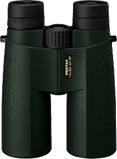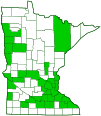Eastern thistle longhorn bee
(Melissodes desponsus)
Conservation • Description • Habitat • Ecology • Distribution • Taxonomy
Conservation Status |
|||
| IUCN Red List | not listed |
||
| NatureServe | NNR - Unranked SNR - Unranked |
||
| Minnesota | not listed |
||
Description
Eastern thistle longhorn bee is a medium-sized, ground-nesting bee. It occurs in the United States and southern Canada east of the Great Plains, but it is absent from the deep south.
Adults are active from late June to early October. They are oligolectic, meaning they collect pollen from only thistles (Cirsium spp.), but they will take nectar from many other flowers.
The female is ½″ to 9⁄16″ (12.0 to 13.5 mm) in length. The body is black.
The head is as wide as the thorax, and it is entirely black except for a yellowish spot at the tip of the mandibles. The plate on the face (clypeus) is entirely black, it is not lobed, and it rather strongly sticks out. The top of the head (vertex) is flat, not rounded, causing the simple eyes (ocelli) to bulge out. The hairs on the head are mostly white, but there is a fringe of black hairs on the rear of the vertex. The antennae have 12 segments, a long scape at the base, a short pedicel, and a whip-like section (flagellum) with 10 segments (flagellomeres). The first flagellomere is twice as long as the shorter side of the second. The flagellomeres are black above, brownish yellow on the underside.
The thorax has mostly whitish hairs. The largest plate on the upper side of the thorax (scutum) has mostly black hairs, but there is a band of white hairs at the front that continues narrowly around on the sides. The hairs are not dense enough to obscure the black surface of the scutum. The small plate on each side above the base of the wing (tegula) is tapered on one side, giving it a tear-drop shape. This is a defining feature of the genus Melissodes, but it is hidden beneath long hairs and cannot be seen without scraping the hairs away.
The first abdominal segment (tergite) has rather abundant erect, whitish hairs at the front and on the sides. Tergites 2 through 4 have a broad, translucent band on the rear margin, and are covered with black hairs at the front.
The legs have mostly short white hairs, but on the front and middle legs there is a patch of brownish-black hairs on the outer surface of the fourth leg segment (tibia). The pollen-collecting hairs (scopa) on the tibia of the hind leg are creamy white, short, and densely feather-like (plumose). The scopa are specially adapted for handling the unique characteristics of Cirsium pollen, which is why the females are so often seen with their fluffy scopa packed with bright white pollen.
The wings are clear at the base, becoming lightly tinted brown near the tip. The veins are brownish to brownish black.
The male is 7⁄16″ to 9⁄16″ (11.0 to 13.5 mm). The clypeus is yellow.
Size
Female total length: ½″ to 9⁄16″ (12.0 to 13.5 mm)
Male total length: 7⁄16″ to 9⁄16″ (11.0 to 13.5 mm)
Similar Species
Habitat
Ecology
Season
Late June to early October
Behavior
Life Cycle
Larva Food/Hosts
Cirsium pollen
Adult Food
Nectar from many genera of flowers
Distribution |
||
|
Sources Biodiversity occurrence data published by: Minnesota Biodiversity Atlas (accessed through the Minnesota Biodiversity Atlas Portal, bellatlas.umn.edu, 10/25/2025). |
|
| 10/25/2025 | ||
Occurrence |
||
|
||
Taxonomy
Order
Hymenoptera (Ants, Bees, Wasps, and Sawflies)
Suborder
Apocrita (Narrow-waisted Wasps, Ants, and Bees)
Infraorder
Aculeata (Ants, Bees, and Stinging Wasps)
Superfamily
Apoidea (Bees and Apoid Wasps)
Epifamily
Family
Apidae (honey bees, bumble bees, and allies)
Subfamily
Apinae (honey, bumble, longhorn, orchid, and digger bees)
Tribe
Eucerini (longhorn bees)
Genus
Subgenus
Subgenus
This species was formerly in the subgenus Heliomelissodes. The primary distinction between Heliomelissodes and Eumelissodes was based on older morphological classifications. Modern genetic studies, however, suggest that Heliomelissodes is not a separate evolutionary lineage and should be merged into the larger Eumelissodes subgenus.
Subordinate Taxa
Synonyms
Melissodes americana
Melissodes cnici
Melissodes desponsa
Melissodes nigripes
Common Names
eastern thistle longhorn
eastern thistle longhorn bee
thistle long-horned bee
Glossary
Clypeus
On insects, a hardened plate on the face above the upper lip (labrum).
Flagellomere
A segment of the whip-like third section of an insect antenna (flagellum).
Ocellus
Simple eye; an eye with a single lens. Plural: ocelli.
Pedicel
On plants: the stalk of a single flower in a cluster of flowers. On insects: the second segment of the antennae. On Hymenoptera and Araneae: the narrow stalk connecting the thorax to the abdomen: the preferred term is petiole.
Plumose
Feathery; having fine, pinnately arranged, lateral bristles or hairs arranged on both sides of an axis.
Scape
In plants: An erect, leafless stalk growing from the rootstock and supporting a flower or a flower cluster. In insects: The basal segment of the antenna.
Scopa
A brush-like tuft of hairs on the legs or underside of the abdomen of a bee used to collect pollen.
Scutum
The forward (anterior) portion of the middle segment of the thorax (mesonotum) in insects and some arachnids.
Tergite
The upper (dorsal), hardened plate on a segment of the thorax or abdomen of an arthropod or myriapod.
Tibia
The fourth segment of an insect leg, after the femur and before the tarsus (foot). The fifth segment of a spider leg or palp. Plural: tibiae.
Vertex
The upper surface of an insect’s head.
Visitor Photos
Share your photo of this insect.
This button not working for you?
Simply email us at info@MinnesotaSeasons.com.
Attach one or more photos and, if you like, a caption.
Dan W. Andree |
||
|
Dark Colored Bee...Whitish Face... I seen this bee and it caught my attention because of its color compared to other bees looked more solid and dark other than the face area. Could be some kind of Longhorn bee maybe? Since it has long antenna and a whitish or light area on the face. Interesting bee. It didn't hang around long but I did get a couple photos of it. |
||
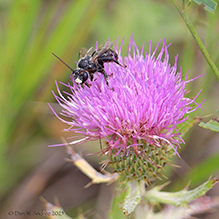 |
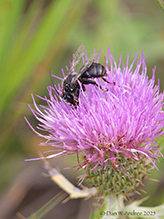 |
|
MinnesotaSeasons.com Photos
|

Slideshows
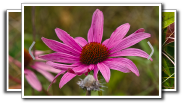
Visitor Videos
Share your video of this insect.
This button not working for you?
Simply email us at info@MinnesotaSeasons.com.
Attach a video, a YouTube link, or a cloud storage link.
Other Videos
Thistle Long-horned Bee pollinating Bull Thistle
Thomas Koffel

Visitor Sightings
Report a sighting of this insect.
This button not working for you?
Simply email us at info@MinnesotaSeasons.com.
Be sure to include a location.
Dan W. Andree
August 2025

Location: MN SNA, Norman Co. Mn.
I seen this bee and it caught my attention because of its color compared to other bees looked more solid and dark other than the face area. Could be some kind of Longhorn bee maybe? Since it has long antenna and a whitish or light area on the face. Interesting bee. It didn't hang around long but I did get a couple photos of it.
MinnesotaSeasons.com Sightings
